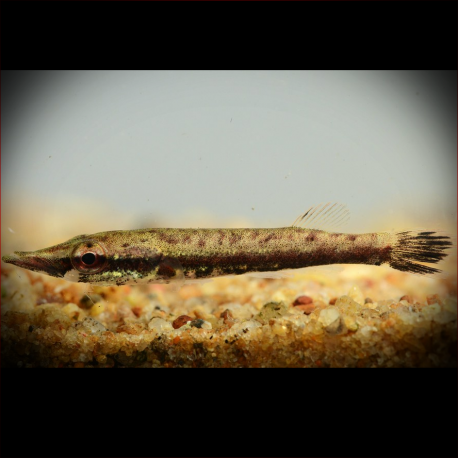More info
Datasheet
| Minimum Tank Size | 113 litres / 29.85 US gallons |
| Maximum Size | 20.0cm / 7.87inches |
| Temperature | 22°C / 71.60°F - 26°C / 78.80°F |
| Hardness | 0-10ºdH |
| pH | 3.0-6.0 |
General Description
The Luciocephalus Pulcher, commonly known as the Giant Pikehead, is a fascinating but challenging species to maintain in captivity. With highly protrusible jaws that can extend up to a third of its body length, this niche predator is perfectly adapted to prey on smaller fish almost half its size. Belonging to the Osphronemid subfamily Luciocephalinae, this species lacks a functioning swim bladder but possesses an accessory breathing organ called the labyrinth, allowing it to breathe atmospheric air to some extent.
Aquarium Setup
To create an ideal environment for the Giant Pikehead, a tank size of at least 113 liters is recommended. Setup should mimic its natural acidic black waters, with substrates like peat fiber, floating vegetation, twigs, branches breaking the surface, and leaf litter such as beech or oak leaves. Maintaining a layer of humid air above the tank is essential, as this species is known to be an excellent jumper. A heavily planted tank with minimal water movement and slow-filtered water is advised. Regular partial water changes are crucial to sustain the high water quality required.
Behaviour
Although the Giant Pikehead can be housed in groups in adequately spacious tanks, it is best kept in a species-only setup to avoid conflicts. This species, while shy, can become threatened if housed with much larger or more vigorous tankmates. Cannibalism is highly likely if group members are not of comparable size. The fish is an ambush predator that remains motionless until prey is within reach and then engulfs it with its enormous mouth.
Feeding and Diet
As a highly piscivorous species, the Giant Pikehead is challenging to wean off live foods and prefers live fish. Earthworms, crickets, and live shrimp are also accepted as alternatives. Creating a separate tank with a colony of livebearers for feeding helps reduce the risk of disease or parasite introduction. Despite efforts, this species rarely accepts dead foods in captivity as successfully as live prey.
Reproduction & Dimorphism
Luciocephalus Pulcher is a paternal mouthbrooder, with the male carrying the eggs in his mouth for approximately 30 days before releasing fully-formed fry. Successfully breeding this species in aquaria is possible, although limited data is available. The sexual dimorphism of this species remains unknown.
Habitat and Distribution
In its natural habitat in parts of Thailand, Malaysia, Indonesia, and Brunei Darussalam, the Giant Pikehead inhabits acidic, stagnant black water habitats like peat swamps. These environments have minimal dissolved mineral content and low pH levels, sometimes as low as 3.0. The dense rainforest canopy above these waters limits light penetration, and the substrate is typically covered with decaying organic material like fallen branches and leaves.
Source: Information provided.

